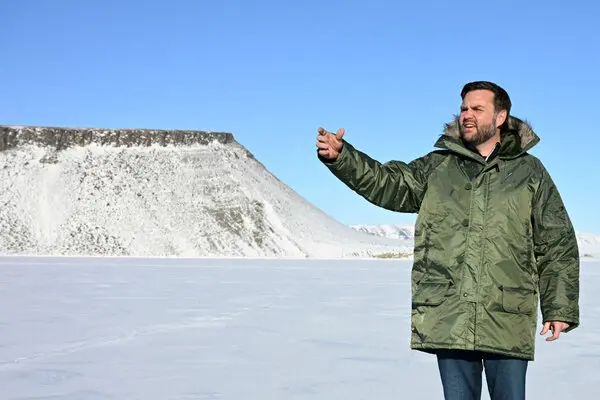On March 28, 2025, Vice President JD Vance stood on the icy grounds of Pituffik Space Base, the northernmost U.S. military outpost in Greenland, and delivered a message that echoed across the Arctic: the Trump administration believes Greenland’s future lies with America—not through force, but through choice. Just hours later, President Donald Trump doubled down from the White House, declaring, “We have to have Greenland.” This bold stance has sparked a firestorm of debate, pitting U.S. ambitions against the will of Greenland’s people and Denmark’s sovereignty. So, what’s really going on here? Let’s break it down.
Greenland isn’t just a frozen island—it’s a strategic goldmine. Roughly three times the size of Texas, it sits northeast of Canada, a semi-autonomous territory under Denmark with a tiny population of about 57,000. Most live along its southern coast, surrounded by ice that covers much of the land. But beneath that ice lies a treasure trove of rare minerals, and above it, a vantage point critical for global security. Vance pointed out during his visit that if an enemy launched a missile at the U.S., the soldiers at Pituffik would be the first to sound the alarm. With Russia and China eyeing the Arctic, the Trump administration sees Greenland as a linchpin in America’s defense.
Vance’s trip wasn’t a solo act. He brought along Second Lady Usha Vance, National Security Adviser Mike Waltz, Secretary of Energy Chris Wright, and Senator Mike Lee of Utah. Originally, Usha planned a cultural tour—think dogsled races and historical sites—but the VP tagged along, shifting the focus to defense and policy. While there, Vance didn’t hold back, slamming Denmark for what he called decades of neglect. “You have underinvested in the people of Greenland,” he said, “and you have underinvested in the security architecture of this incredible, beautiful landmass.” His words were sharp, accusing Denmark of leaving the U.S. base less secure than it once was—a jab at a longtime ally.
President Trump, meanwhile, has been obsessed with Greenland since his first term, when he floated the idea of buying it. Now, he’s back at it, calling it essential for “international world security.” He’s even hinted at military force, though Vance insists that won’t happen. “We think the Greenlanders are going to choose independence from Denmark,” Vance said, “and then we’ll have conversations with them.” It’s a classic Trump-style deal in the making: no guns, just negotiation. But here’s the catch—Greenlanders don’t seem to want it. A recent poll showed 85% oppose joining the U.S., and locals like Daniel Rosing, a young electrician, are blunt: “He can’t just take it like that.”
The pushback isn’t just from Greenland. Prime Minister Múte Bourup Egede called the U.S. pressure “aggressive,” while Denmark’s leader, Mette Frederiksen, labeled it “unacceptable.” They’re not wrong to feel cornered—Trump’s also mused about annexing Canada and the Panama Canal, painting a picture of an administration hungry for territory. Yet, Vance and Trump frame this as a rescue mission. They argue Denmark’s let Greenland languish, opening the door for rivals like China to swoop in. A statement from Vance’s office even claimed that past U.S. and Danish leaders “presented our adversaries with the opportunity to advance their own priorities in Greenland and the Arctic.”
History backs up some of this. During World War II, the U.S. built bases in Greenland to fend off Nazis. In the Cold War, it was a shield against Soviet missiles. Today, it’s about staying ahead in a warming Arctic, where melting ice means new shipping routes and resource grabs. Waltz, speaking to soldiers at Pituffik, called them part of a proud “tradition,” while Vance thanked them for their year-long stints away from family. “The mission is really important,” he said, “and it’s only going to get bigger.”
So, is this a brilliant move or a reckless overreach? On one hand, the U.S. has a real stake in Greenland—its location and resources could tip the scales in a tense world. Trump and Vance see a chance to flex American muscle and secure the future. On the other, they’re bulldozing over Greenlanders’ wishes and risking a rift with Denmark, a NATO ally. The duo’s confidence in a “deal” assumes a lot—like Greenlanders suddenly ditching their identity for stars and stripes. For now, the Trump administration’s charging ahead, but whether they’ll win over hearts or just stoke resentment remains the million-dollar question in this icy standoff.
